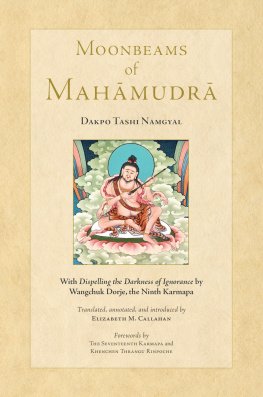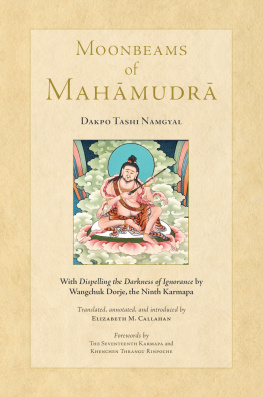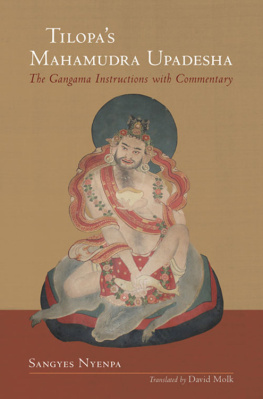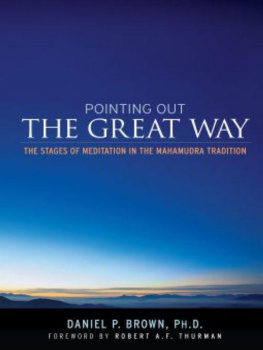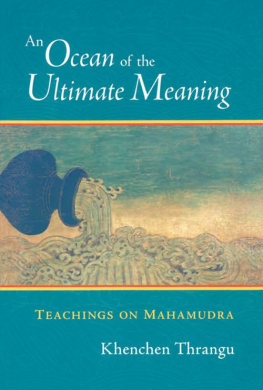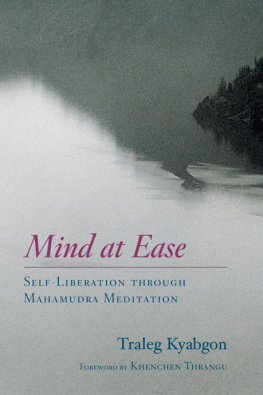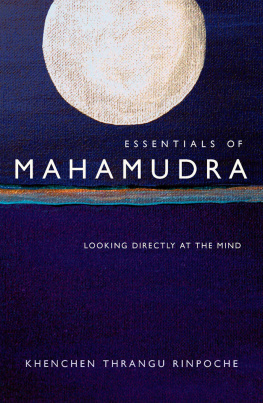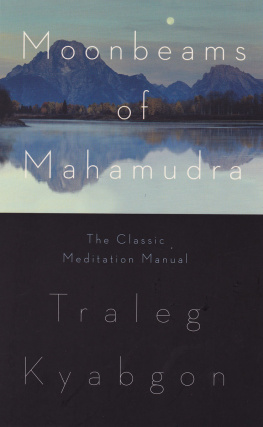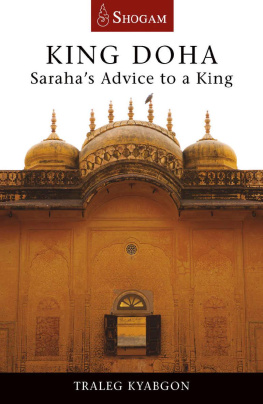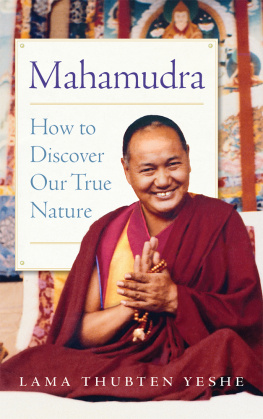Table of Contents
This great classic is dedicated
to all Buddhist masters and meditators.
LOBSANG PHUNTSHOG LHALUNGPA
FOREWORD
by His Holiness The Fourteenth Dalai Lama
Lobsang Phuntshog Lhalungpa translated Mahamudra, The Moonlight [ Quintessence of Mind and Meditation ] from the Tibetan text composed by Dakpo Tashi Namgyal [1511 1587]. During the many years since its publication, the English version has helped numerous serious Dharma students. It is excellent that the second edition is now being brought out.
It is my prayer and wish that, given the proper devotion to listening [to discourses], appreciation, and meditation, devotees may be able to arrive at the regal realm of permanent happiness.
Dalai Lama
September 3, 1998
Earth Tiger Year, 7th month, 12th lunar phase
in the era of 17th sexagenarian cycle (rab-jung chu-dun-pa)
PREFACE
To the First Edition
Mah amudra: The Quintessence of Mind and Meditation was translated from 1976 to 1977. The finalization was done in stages, from 1981 to 1983, in between my other work. I paid special attention to the careful checking of the entire translation and editorial work, to the preparation of footnotes, to the bibliography of the Sanskrit and Tibetan titles of the Tibetan texts quoted in this treatise, and to the index.
For many years I have devoted myself to the translation of Tibetan literature both secular and religious into English, but have delayed publishing my translations of Buddhist texts in order to ensure their complete accuracy. None of us in the tradition has any illusions about being able to achieve the same high standard of writing and translating as that of the learned and enlightened Lama-Lotsavas of ancient Tibet, who translated Buddhist works from many other languages. Besides, the conditions for serious translators are not favorable in these modern times. Yet a series of significant events in my life finally brought about the translation of this great esoteric text.
Since 1959, when many thousands of Tibetans escaped to India and other neighboring countries, I had been asked to translate Buddhist texts by the highest authority within our tradition and by many of my Lamas. In 1969 the late Venerable Dukchen Thuksay Rinpoche, renowned master of the Drukpa Kagy Order, presented me with a xylographed print of a Tibetan text during an assembly at Sangngak Chling Monastery in Darjeeling (India). While blessing me, Rinpoche, in his gentle voice, said: This is the most important sacred text! I urge you to translate it. When I opened the book and read the title, I was deeply moved. Here was the Mahamudra text, one of the great Buddhist classics that I had already been studying.
A few years later, His Holiness Karmapa Rigpei Dorje, the Sixteenth Karmapa, presented me with seven great commentaries on the sutric and tantric teachings. He also handed me a certificate bearing his seal that assigned me the task of translating these texts. On the list of titles this Mahamudra text was especially marked for translation.
Finally, during a visit to New York in 1975, Dr. C. T. Shen, president of the Institute for Advanced Studies of World Religions at Stonybrook, offered me a contract for translating the same Mah amudra text. Dr. Shen also invited the Venerable Dezhung Rinpoche to be adviser for this project. In addition to his generous financial support, Dr. Shen provided us with a lovely, quiet residence on his Long Island estate of Bodhifield. Throughout our two-year stay there, both Dr. and Mrs. Shen extended to us every possible courtesy and assistance. I personally and all of us in the Dharma are indeed deeply indebted to Dr. Shen, especially since his sponsorship represents only one of his many invaluable projects for the advancement of Buddhism. I here also express my deep respect and appreciation to the Venerable Dezhung Rinpoche, a great eclectic Lama and a teacher of the Sakyapa Order, for his advice and explanations of the difficult passages found in this text.
My sincere appreciation and thanks are due to my family for their encouragement and support: to my wife, Gisela Minke, for having enthusiastically and tirelessly typed and checked the English; to my son Samphe Dorje for his invaluable help in editing the first part of the translation; and to my younger son, Nawang Tenzin, for providing me with much practical help.
I wish to acknowledge with deep appreciation the advice and assistance given by a number of individuals: first and foremost my dear friends Mary Ann and Lawrence Tucker, who have consistently encouraged and supported me; my friend Ani Tsering Chodon (Martha Hamilton) for checking and typing the bilingual bibliography of the titles quoted in Mahamudra ; the Venerable Chogyam Trungpa, Rinpoche, Dr. Herbert V. Guenther, and Dr. Garma C. C. Chang for reading my list of Buddhist technical terms in English and Tibetan; and also my friends Gene Smith, Hannah Robinson, Dr. Gloria Count-van Manen, and Elizabeth Dale for having read parts of the translation and for having encouraged me.
My sincere appreciation and thanks also go to the staff of the Institute for Advanced Studies of World Religions at Stonybrook, Long Island, for making available to me many Tibetan texts and for allowing me to use the facilities of the institute.
I want to express special thanks to those institutions and individuals who have provided me with some of the funds required for the finalization. The major part of this expense and much voluntary assistance came from my own family. I am very grateful to Buddhayana Foundation in Massachusetts, to the Marsden Foundation in New York, and to Mr. Michael Wunmbrand for providing me with part of the funding.
Last but not least, I am very grateful indeed to my publisher, Mr. Samuel Bercholz, of Shambhala, who took a personal interest in this publication.
The xylographed text of Mahamudra used in this translation was printed on handmade Tibetan paper from carved woodblocks that had been preserved at Sri Neuteng of Gyal, in Dingri, western Tibet, until the cultural revolution. The folio numbers of this text appear in the left-hand margins of this English translation.
Since this text is an original Tibetan composition and contains numerous terms of distinct Tibetan character, I have included a limited list of Sanskrit equivalents.
The Tibetan script (which was adapted from an ancient Indian script) employs many silent letters. The recent practice of literally transcribing Tibetan words seems only to confuse foreign readers. I myself was surprised and amused when I first read my name in English as bLobzang Phuntshogs. In this text I have deliberately adhered to the more practical phonetic rendering, which facilitates smooth reading.
Despite my dedicated efforts, there could still be errors and inaccuracies in this translation. If so, I sincerely apologize for these shortcomings.
I must confess that in both the translation and in my introduction I have addressed myself mainly to practicing Buddhists and only partly to the general readership. It is my sincere wish that this great text may serve practicing Buddhists as an illuminating guide while conveying the Buddhas message of universal enlightenment, thus fulfilling the noble goal of the sponsor and of all others directly involved with this effort.


